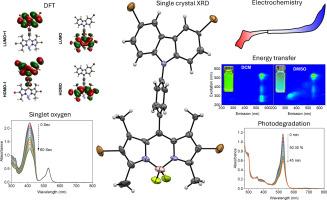Investigation of the structural, optical, and electrochemical properties of a BODIPY system functionalized with carbazole and bromine moieties
IF 5.4
3区 化学
Q1 CHEMISTRY, INORGANIC & NUCLEAR
引用次数: 0
Abstract
In this study, a novel tetrabromo-substituted BODIPY derivative containing a carbazole unit (Br4-CB) was synthesized, and its structural, photophysical, and electrochemical properties were thoroughly investigated. Single-crystal X-ray diffraction analysis revealed a molecular architecture stabilized by halogen–halogen interactions, featuring extended π-conjugation and pronounced intermolecular π–π stacking. Optical measurements conducted in various solvents showed strong absorption and emission characteristics, high fluorescence quantum yields reaching up to 0.98 in hexane, and significant solvent-dependent Stokes shifts. Br4-CB exhibited a singlet oxygen quantum yield (ΦΔ) of 0.50 in DMSO. Furthermore, efficient energy transfer from the carbazole moiety to the BODIPY core was observed in DCM, as confirmed by fluorescence measurements, accompanied by a notably prolonged fluorescence lifetime compared to other solvents (τ = 12.9 ns). Electrochemical analyses and DFT calculations revealed consistent HOMO-LUMO energy levels and a narrow bandgap (Egap = 1.37–1.40 eV), highlighting the compound's potential as a semiconducting material. Overall, the synergistic effect of the carbazole and bromine functionalities effectively modulates the physicochemical behavior of the BODIPY framework, positioning Br4-CB as a promising core structure for light-harvesting applications.

以咔唑和溴基团功能化的BODIPY体系的结构、光学和电化学性质的研究
本研究合成了一种新型含咔唑基的四溴取代BODIPY衍生物(Br4-CB),并对其结构、光物理和电化学性质进行了深入研究。单晶x射线衍射分析表明,分子结构由卤素-卤素相互作用稳定,具有扩展的π共轭和明显的分子间π -π堆叠。在各种溶剂中进行的光学测量显示出强的吸收和发射特性,在己烷中荧光量子产率高达0.98,以及明显的溶剂依赖性斯托克斯位移。Br4-CB在DMSO中的单线态氧量子产率(ΦΔ)为0.50。此外,在DCM中观察到咔唑部分向BODIPY核心的有效能量转移,荧光测量证实了这一点,与其他溶剂相比,DCM的荧光寿命明显延长(τ = 12.9 ns)。电化学分析和DFT计算表明,HOMO-LUMO具有一致的能级和较窄的带隙(Egap = 1.37-1.40 eV),突出了该化合物作为半导体材料的潜力。总体而言,咔唑和溴的协同作用有效地调节了BODIPY框架的物理化学行为,将Br4-CB定位为光捕获应用的有前途的核心结构。
本文章由计算机程序翻译,如有差异,请以英文原文为准。
求助全文
约1分钟内获得全文
求助全文
来源期刊

Inorganic Chemistry Communications
化学-无机化学与核化学
CiteScore
5.50
自引率
7.90%
发文量
1013
审稿时长
53 days
期刊介绍:
Launched in January 1998, Inorganic Chemistry Communications is an international journal dedicated to the rapid publication of short communications in the major areas of inorganic, organometallic and supramolecular chemistry. Topics include synthetic and reaction chemistry, kinetics and mechanisms of reactions, bioinorganic chemistry, photochemistry and the use of metal and organometallic compounds in stoichiometric and catalytic synthesis or organic compounds.
 求助内容:
求助内容: 应助结果提醒方式:
应助结果提醒方式:


